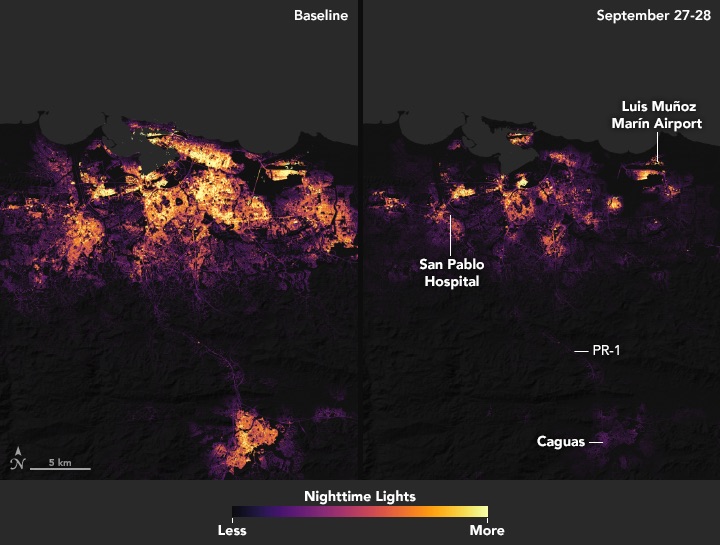Puerto Rico's Dramatic Power Loss Shown in Satellite Photos

A NASA/NOAA satellite captured nighttime images of Puerto Rico last week, revealing regions on the territory that are without power, due to Hurricane Maria.
The images show Puerto Rico's major cities lit up by human activity before the storm's arrival on Sept. 20. But composite images taken on Sept. 27 and Sept. 28 show the drastic reduction in human-produced lights due to nation-wide power outages.
"Quickly knowing where the power is out — and how long it has been out — allows first responders to better deploy rescue and repair crews and to distribute life-saving supplies," agency officials wrote on the NASA Disaster Response blog. "Teams of scientists at NASA are working long days to make sure that groups like the National Guard and the Federal Emergency Management Agency (FEMA) get high-quality satellite maps of power outages in Puerto Rico." [Hurricane Maria from Space: Latest Images and Videos]
The images were taken with the Visible Infrared Imaging Radiometer Suite (VIIRS) instrument on the Suomi National Polar-orbiting Partnership satellite, which is jointly operated by NASA and the National Oceanic and Atmospheric Administration (NOAA).
The satellite captured the images using its "day-night band," which detects light from a wide range of sources, including things like lightning, but also human activity, according to a second NASA blog post. The images are "processed and corrected … to filter out stray light from the moon, fires, airglow and any other sources that are not electric lights."
The images showing Puerto Rico before Maria were created using observations taken over many nights, in order to cut out cloud cover. In the images compiled over the nights of Sept. 27 and 28, cloud cover affects some areas, including the southeast and western portions of the island. But the images show clearly the loss of power in the island's biggest city, San Juan.
NASA scientists overlaid the satellite observations onto a base map that shows streets and neighborhoods, providing first responders with more-specific information about the locations of power outages. The base map utilized data from four additional satellites.
Breaking space news, the latest updates on rocket launches, skywatching events and more!
On Sept. 25, NOAA tweeted an additional before-and-after satellite image of Puerto Rico at night. The images provide a glimpse at the extensive loss of power throughout the island. NOAA representatives did not say whether the images had been processed, and whether all of the light shown in the images is human-produced.
Over 1,000 people are believed to have died in Puerto Rico because of the storm, although some estimates place that number closer to 2,000. Because Puerto Rico is an unincorporated U.S. territory, it is entitled to U.S. federal emergency aid. FEMA is currently responding to the disaster, but restoring power in Puerto Rico could take months.
Follow Calla Cofield @callacofield. Follow us @Spacedotcom, Facebook and Google+. Original article on Space.com.

Calla Cofield joined Space.com's crew in October 2014. She enjoys writing about black holes, exploding stars, ripples in space-time, science in comic books, and all the mysteries of the cosmos. Prior to joining Space.com Calla worked as a freelance writer, with her work appearing in APS News, Symmetry magazine, Scientific American, Nature News, Physics World, and others. From 2010 to 2014 she was a producer for The Physics Central Podcast. Previously, Calla worked at the American Museum of Natural History in New York City (hands down the best office building ever) and SLAC National Accelerator Laboratory in California. Calla studied physics at the University of Massachusetts, Amherst and is originally from Sandy, Utah. In 2018, Calla left Space.com to join NASA's Jet Propulsion Laboratory media team where she oversees astronomy, physics, exoplanets and the Cold Atom Lab mission. She has been underground at three of the largest particle accelerators in the world and would really like to know what the heck dark matter is. Contact Calla via: E-Mail – Twitter


